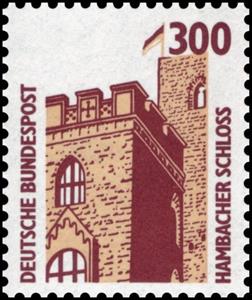Stamp: Hambacher castle (Germany, Federal Republic 1992)
Hambacher castle (Germany, Federal Republic 1992)
01 January (Germany, Federal Republic ) within release Sights goes into circulation Stamp Hambacher castle face value 300 German pfennig
| Stamp Hambacher castle in catalogues | |
|---|---|
| Michel: | Mi: DE 1348AvRI |
Stamp is vertical format.
Coil stamp with horizontal back numberAlso in the issue Sights:
- Stamp - Tower of the Freiburg Minster face value 50;
- Stamp - Frankfurt Airport face value 10;
- Stamp - Main entrance of the mine Zollern II, Dortmund face value 80;
- Stamp - Nefertiti bust, Berlin face value 20;
- Stamp - Hambach castle face value 300;
- Stamp - Chile house, Hamburg face value 40;
- Stamp - Chile house, Hamburg face value 40;
- Stamp - Tower of the Freiburg Minster face value 50;
- Stamp - Frankfurt Airport face value 10;
- Stamp - Bronze pot, Reinheim face value 140;
- Stamp - Hambacher castle face value 300;
- Stamp - Main entrance of the mine Zollern II, Dortmund face value 80;
- Stamp - Nefertiti bust, Berlin face value 20;
- Stamp - St. Peter's Cathedral, Schleswig face value 33;
- Stamp - Bavaria, Munich face value 60;
- Stamp - Chile house, Hamburg face value 40;
- Stamp - Bavaria, Munich face value 60;
- Stamp - Frankfurt Airport face value 10;
- Stamp - Hambach Castle face value 300;
- Stamp - Tower of Freiburg Cathedral face value 50;
- Stamp - Zollern II Dortmund Mine Industrial Museum, Westphalia face value 80;
Stamp Hambacher castle it reflects the thematic directions:
A building or edifice is a structure with a roof and walls standing more or less permanently in one place, such as a house or factory. Buildings come in a variety of sizes, shapes and functions, and have been adapted throughout history for a wide number of factors, from building materials available, to weather conditions, to land prices, ground conditions, specific uses and aesthetic reasons. Buildings serve several needs of society – primarily as shelter from weather, security, living space, privacy, to store belongings, and to comfortably live and work. A building as a shelter represents a physical division of the human habitat (a place of comfort and safety) and the outside (a place that at times may be harsh and harmful).
A flag is a piece of fabric (most often rectangular or quadrilateral) with a distinctive design that is used as a symbol, as a signaling device, or as decoration. The term flag is also used to refer to the graphic design employed, and flags have since evolved into a general tool for rudimentary signalling and identification, especially in environments where communication is similarly challenging (such as the maritime environment where semaphore is used). National flags are patriotic symbols with varied wide-ranging interpretations, often including strong military associations due to their original and ongoing military uses. Flags are also used in messaging, advertising, or for other decorative purposes. The study of flags is known as vexillology, from the Latin word vexillum, meaning flag or banner.
A palace is a large residence, often serving as a royal residence or the home for a head of state or another high-ranking dignitary, such as a bishop or archbishop. The word is derived from the Latin name palātium, for Palatine Hill in Rome which housed the Imperial residences



